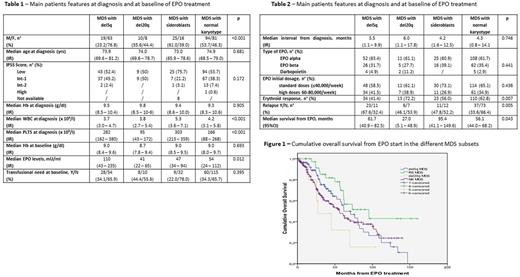Abstract
Background Erythropoietin (EPO) has been widely employed as first-line approach in the treatment of all patients with low-risk Myelodysplastic Syndromes (MDS) and anemia, with response rates ranging from 30 to 60%. Among all low-risk MDS patients, however, there is increasing attention to recognize different subsets characterized by specific karyotipic (del5q-, del20q-), molecular or morphologic (ring sideroblasts) features and, in some cases, by very effective specific treatments (lenalidomide, luspatercept). The role of EPO treatment in these subsets has been very rarely evaluated and is still a matter of debat.
Methods To address this issue, the Gruppo Laziale Mielodisplasie (GROM-L) revised retrospectively 316 MDS patients treated with EPO from 1/2002 to 12/2010 by 11 Hematological Centers (5 university hospitals and 6 community-based hospitals) in the metropolitan area of Rome and belonging to 4 different subsets: 82 patients with del5q- isolated or associated to 1 other karyotypic alteration (del5 group), 18 patients with isolated del20q- (del20 group), 41 patients with ring sideroblasts > 15% (RS group) and 175 patients with normal karyotype (NK group) as control group. The main features of these 4 groups are reported in Table 1.
Results In Table 2are reported median intervals from diagnosis to EPO start, types of EPO and initial EPO dosages as well as rates of erythroid response (Hb increase > 1.5 g/dl and/or disappearance of transfusion requirement) in the 4 MDS groups. In particular, compared with NK group as control cohort, del5q group had a significant lower rate of erythroid response (p=0.001), while del20q and RS groups showed a similar rate (p=0.431 and p=0.425, respectively). The number of patients with a relapse during EPO treatment was significantly lower in the NK group compared to the other 3 groups, as shown in Table 2 (p=0.005). Median overall survival (OS) from EPO start in the 4 groups is reported in Table 2 while cumulative OS is shown in Figure 1: compared with NK group, only RS group had a better cumulative OS (p=0.026), while both del5q and del20q groups had similar OS (p=0.455 and p=0.367, respectively).
Conclusions Our real-life data from a single homogeneous geographic area outline that EPO treatment is effective in all subsets of low-risk MDS considered in this study: the del5q- group had a lower rate of erythroid response, which in any case exceeded 40% of patients. These data, coupled with the excellent toxicity profile of EPO, seem reinforce this treatment as 1st line approach also in those subsets of MDS with specific and very effective (but also quite toxic) new drugs
Breccia: Incyte: Consultancy; Bristol Myers Squibb: Consultancy; Pfizer: Consultancy; Novartis: Consultancy.
Author notes
Asterisk with author names denotes non-ASH members.


This feature is available to Subscribers Only
Sign In or Create an Account Close Modal